- Home
- Edgar Allan Poe
The Works of Edgar Allan Poe — Volume 4 Page 18
The Works of Edgar Allan Poe — Volume 4 Read online
Page 18
MAELZEL'S CHESS-PLAYER
PERHAPS no exhibition of the kind has ever elicited so general attentionas the Chess-Player of Maelzel. Wherever seen it has been an object ofintense curiosity, to all persons who think. Yet the question of its_modus operandi is _still undetermined. Nothing has been written on thistopic which can be considered as decisive--and accordingly we findevery where men of mechanical genius, of great general acuteness, anddiscriminative understanding, who make no scruple in pronouncingthe Automaton a _pure machine, _unconnected with human agency in itsmovements, and consequently, beyond all comparison, the most astonishingof the inventions of mankind. And such it would undoubtedly be, werethey right in their supposition. Assuming this hypothesis, it would begrossly absurd to compare with the Chess-Player, any similar thing ofeither modern or ancient days. Yet there have been many and wonderfulautomata. In Brewster's Letters on Natural Magic, we have an accountof the most remarkable. Among these may be mentioned, as having beyonddoubt existed, firstly, the coach invented by M. Camus for the amusementof Louis XIV when a child. A table, about four feet square, wasintroduced, into the room appropriated for the exhibition. Upon thistable was placed a carriage, six inches in length, made of wood, anddrawn by two horses of the same material. One window being down, a ladywas seen on the back seat. A coachman held the reins on the box, anda footman and page were in their places behind. M. Camus now toucheda spring; whereupon the coachman smacked his whip, and the horsesproceeded in a natural manner, along the edge of the table, drawingafter them the carriage. Having gone as far as possible in thisdirection, a sudden turn was made to the left, and the vehicle wasdriven at right angles to its former course, and still closely alongthe edge of the table. In this way the coach proceeded until it arrivedopposite the chair of the young prince. It then stopped, the pagedescended and opened the door, the lady alighted, and presented apetition to her sovereign. She then re-entered. The page put up thesteps, closed the door, and resumed his station. The coachman whippedhis horses, and the carriage was driven back to its original position.
The magician of M. Maillardet is also worthy of notice. We copy thefollowing account of it from the _Letters _before mentioned of Dr. B.,who derived his information principally from the Edinburgh Encyclopaedia.
"One of the most popular pieces of mechanism which we have seen, Isthe Magician constructed by M. Maillardet, for the purpose of answeringcertain given questions. A figure, dressed like a magician, appearsseated at the bottom of a wall, holding a wand in one hand, and a bookin the other A number of questions, ready prepared, are inscribed onoval medallions, and the spectator takes any of these he chooses andto which he wishes an answer, and having placed it in a drawer ready toreceive it, the drawer shuts with a spring till the answer is returned.The magician then arises from his seat, bows his head, describes circleswith his wand, and consulting the book as If in deep thought, he liftsit towards his face. Having thus appeared to ponder over the proposedquestion he raises his wand, and striking with it the wall above hishead, two folding doors fly open, and display an appropriate answer tothe question. The doors again close, the magician resumes his originalposition, and the drawer opens to return the medallion. There are twentyof these medallions, all containing different questions, to which themagician returns the most suitable and striking answers. The medallionsare thin plates of brass, of an elliptical form, exactly resembling eachother. Some of the medallions have a question inscribed on each side,both of which the magician answered in succession. If the drawer is shutwithout a medallion being put into it, the magician rises, consults hisbook, shakes his head, and resumes his seat. The folding doors remainshut, and the drawer is returned empty. If two medallions are put intothe drawer together, an answer is returned only to the lower one. Whenthe machinery is wound up, the movements continue about an hour, duringwhich time about fifty questions may be answered. The inventor statedthat the means by which the different medallions acted upon themachinery, so as to produce the proper answers to the questions whichthey contained, were extremely simple."
The duck of Vaucanson was still more remarkable. It was _of _the sizeof life, and so perfect an imitation of the living animal that all thespectators were deceived. It executed, says Brewster, all the naturalmovements and gestures, it ate and drank with avidity, performed all thequick motions of the head and throat which are peculiar to the duck, andlike it muddled the water which it drank with its bill. It producedalso the sound of quacking in the most natural manner. In the anatomicalstructure the artist exhibited the highest skill. Every bone in thereal duck had its representative In the automaton, and its wings wereanatomically exact. Every cavity, apophysis, and curvature was imitated,and each bone executed its proper movements. When corn was thrown downbefore it, the duck stretched out its neck to pick it up, swallowed, anddigested it. {*1}
But if these machines were ingenious, what shall we think of thecalculating machine of Mr. Babbage? What shall we think of an engine ofwood and metal which can not only compute astronomical and navigationtables to any given extent, but render the exactitude of its operationsmathematically certain through its power of correcting its possibleerrors? What shall we think of a machine which can not only accomplishall this, but actually print off its elaborate results, when obtained,without the slightest intervention of the intellect of man? It will,perhaps, be said, in reply, that a machine such as we have describedis altogether above comparison with the Chess-Player of Maelzel. By nomeans--it is altogether beneath it--that is to say provided we assume(what should never for a moment be assumed) that the Chess-Player is a_pure machine, _and performs its operations without any immediate humanagency. Arithmetical or algebraical calculations are, from their verynature, fixed and determinate. Certain _data _being given, certainresults necessarily and inevitably follow. These results have dependenceupon nothing, and are influenced by nothing but the _data _originallygiven. And the question to be solved proceeds, or should proceed, toits final determination, by a succession of unerring steps liable tono change, and subject to no modification. This being the case, we canwithout difficulty conceive the _possibility _of so arranging a pieceof mechanism, that upon starting In accordance with the _data _of thequestion to be solved, it should continue its movements regularly,progressively, and undeviatingly towards the required solution, sincethese movements, however complex, are never imagined to be otherwisethan finite and determinate. But the case is widely different with theChess-Player. With him there is no determinate progression. No one movein chess necessarily follows upon any one other. From no particulardisposition of the men at one period of a game can we predicate theirdisposition at a different period. Let us place the _first move _ina game of chess, in juxta-position with the _data _of an algebraicalquestion, and their great difference will be immediately perceived. Fromthe latter--from the _data--_the second step of the question, dependentthereupon, inevitably follows. It is modelled by the _data. _It must be_thus _and not otherwise. But from the first move in the game ofchess no especial second move follows of necessity. In the algebraicalquestion, as it proceeds towards solution, the _certainty _of itsoperations remains altogether unimpaired. The second step having beena consequence of the _data, _the third step is equally a consequence ofthe second, the fourth of the third, the fifth of the fourth, and soon, _and not possibly otherwise, _to the end. But in proportion to theprogress made in a game of chess, is the _uncertainty _of each ensuingmove. A few moves having been made, _no _step is certain. Differentspectators of the game would advise different moves. All is thendependent upon the variable judgment of the players. Now even granting(what should not be granted) that the movements of the AutomatonChess-Player were in themselves determinate, they would be necessarilyinterrupted and disarranged by the indeterminate will of his antagonist.There is then no analogy whatever between the operations of theChess-Player, and those of the calculating machine of Mr. Babbage, andif we choose to call the former a _pure machine _we must be preparedto admit that it is, beyond all comparison, the mos
t wonderful of theinventions of mankind. Its original projector, however, Baron Kempelen,had no scruple in declaring it to be a "very ordinary piece ofmechanism--a _bagatelle _whose effects appeared so marvellous only fromthe boldness of the conception, and the fortunate choice of the methodsadopted for promoting the illusion." But it is needless to dwell uponthis point. It is quite certain that the operations of the Automatonare regulated by _mind, _and by nothing else. Indeed this matter issusceptible of a mathematical demonstration, _a priori. _The onlyquestion then is of the _manner _in which human agency is brought tobear. Before entering upon this subject it would be as well to give abrief history and description of the Chess-Player for the benefit ofsuch of our readers as may never have had an opportunity of witnessingMr. Maelzel's exhibition.
The Automaton Chess-Player was invented in 1769, by Baron Kempelen,a nobleman of Presburg, in Hungary, who afterwards disposed of it,together with the secret of its operations, to its present possessor.{2*} Soon after its completion it was exhibited in Presburg, Paris,Vienna, and other continental cities. In 1783 and 1784, it was taken toLondon by Mr. Maelzel. Of late years it has visited the principal townsin the United States. Wherever seen, the most intense curiosity wasexcited by its appearance, and numerous have been the attempts, by menof all classes, to fathom the mystery of its evolutions. The cut onthis page gives a tolerable representation of the figure as seen by thecitizens of Richmond a few weeks ago. The right arm, however, should liemore at length upon the box, a chess-board should appear upon it, andthe cushion should not be seen while the pipe is held. Some immaterialalterations have been made in the costume of the player since itcame into the possession of Maelzel--the plume, for example, was notoriginally worn. {image of automaton}
At the hour appointed for exhibition, a curtain is withdrawn, or foldingdoors are thrown open, and the machine rolled to within about twelvefeet of the nearest of the spectators, between whom and it (the machine)a rope is stretched. A figure is seen habited as a Turk, and seated,with its legs crossed, at a large box apparently of maple wood, whichserves it as a table. The exhibiter will, if requested, roll the machineto any portion of the room, suffer it to remain altogether on anydesignated spot, or even shift its location repeatedly during theprogress of a game. The bottom of the box is elevated considerably abovethe floor by means of the castors or brazen rollers on which it moves,a clear view of the surface immediately beneath the Automaton beingthus afforded to the spectators. The chair on which the figure sitsis affixed permanently to the box. On the top of this latter is achess-board, also permanently affixed. The right arm of the Chess-Playeris extended at full length before him, at right angles with his body,and lying, in an apparently careless position, by the side of the board.The back of the hand is upwards. The board itself is eighteen inchessquare. The left arm of the figure is bent at the elbow, and in the lefthand is a pipe. A green drapery conceals the back of the Turk, and fallspartially over the front of both shoulders. To judge from the externalappearance of the box, it is divided into five compartments--threecupboards of equal dimensions, and two drawers occupying that portion ofthe chest lying beneath the cupboards. The foregoing observations applyto the appearance of the Automaton upon its first introduction into thepresence of the spectators.
Maelzel now informs the company that he will disclose to their viewthe mechanism of the machine. Taking from his pocket a bunch of keys heunlocks with one of them, door marked ~ in the cut above, and throws thecupboard fully open to the inspection of all present. Its whole interioris apparently filled with wheels, pinions, levers, and other machinery,crowded very closely together, so that the eye can penetrate but alittle distance into the mass. Leaving this door open to its fullextent, he goes now round to the back of the box, and raising thedrapery of the figure, opens another door situated precisely in therear of the one first opened. Holding a lighted candle at this door, andshifting the position of the whole machine repeatedly at the same time,a bright light is thrown entirely through the cupboard, which is nowclearly seen to be full, completely full, of machinery. The spectatorsbeing satisfied of this fact, Maelzel closes the back door, locks it,takes the key from the lock, lets fall the drapery of the figure, andcomes round to the front. The door marked I, it will be remembered, isstill open. The exhibiter now proceeds to open the drawer which liesbeneath the cupboards at the bottom of the box--for although there areapparently two drawers, there is really only one--the two handles andtwo key holes being intended merely for ornament. Having opened thisdrawer to its full extent, a small cushion, and a set of chessmen, fixedin a frame work made to support them perpendicularly, are discovered.Leaving this drawer, as well as cupboard No. 1 open, Maelzel now unlocksdoor No. 2, and door No. 3, which are discovered to be folding doors,opening into one and the same compartment. To the right of thiscompartment, however, (that is to say the spectators' right) a smalldivision, six inches wide, and filled with machinery, is partitionedoff. The main compartment itself (in speaking of that portion of thebox visible upon opening doors 2 and 3, we shall always call it the maincompartment) is lined with dark cloth and contains no machinery whateverbeyond two pieces of steel, quadrant-shaped, and situated one in eachof the rear top corners of the compartment. A small protuberance abouteight inches square, and also covered with dark cloth, lies on the floorof the compartment near the rear corner on the spectators' left hand.Leaving doors No. 2 and No. 3 open as well as the drawer, and door No.I, the exhibiter now goes round to the back of the main compartment,and, unlocking another door there, displays clearly all the interior ofthe main compartment, by introducing a candle behind it and within it.The whole box being thus apparently disclosed to the scrutiny of thecompany, Maelzel, still leaving the doors and drawer open, rolls theAutomaton entirely round, and exposes the back of the Turk by lifting upthe drapery. A door about ten inches square is thrown open in the loinsof the figure, and a smaller one also in the left thigh. The interior ofthe figure, as seen through these apertures, appears to be crowded withmachinery. In general, every spectator is now thoroughly satisfied ofhaving beheld and completely scrutinized, at one and the same time,every individual portion of the Automaton, and the idea of any personbeing concealed in the interior, during so complete an exhibitionof that interior, if ever entertained, is immediately dismissed aspreposterous in the extreme.
M. Maelzel, having rolled the machine back into its original position,now informs the company that the Automaton will play a game of chesswith any one disposed to encounter him. This challenge being accepted,a small table is prepared for the antagonist, and placed close by therope, but on the spectators' side of it, and so situated as not toprevent the company from obtaining a full view of the Automaton. From adrawer in this table is taken a set of chess-men, and Maelzel arrangesthem generally, but not always, with his own hands, on the chess board,which consists merely of the usual number of squares painted upon thetable. The antagonist having taken his seat, the exhibiter approachesthe drawer of the box, and takes therefrom the cushion, which, afterremoving the pipe from the hand of the Automaton, he places under itsleft arm as a support. Then taking also from the drawer the Automaton'sset of chess-men, he arranges them upon the chessboard before thefigure. He now proceeds to close the doors and to lock them--leaving thebunch of keys in door No. 1. He also closes the drawer, and, finally,winds up the machine, by applying a key to an aperture in the left end(the spectators' left) of the box. The game now commences--the Automatontaking the first move. The duration of the contest is usually limitedto half an hour, but if it be not finished at the expiration of thisperiod, and the antagonist still contend that he can beat the Automaton,M. Maelzel has seldom any objection to continue it. Not to wearythe company, is the ostensible, and no doubt the real object of thelimitation. It Wits of course be understood that when a move is made athis own table, by the antagonist, the corresponding move is made atthe box of the Automaton, by Maelzel himself, who then acts as therepresentative of the antagonist. On the other hand, when the Turkmoves, the correspond
ing move is made at the table of the antagonist,also by M. Maelzel, who then acts as the representative of theAutomaton. In this manner it is necessary that the exhibiter shouldoften pass from one table to the other. He also frequently goes in rearof the figure to remove the chess-men which it has taken, and which itdeposits, when taken, on the box to the left (to its own left) ofthe board. When the Automaton hesitates in relation to its move, theexhibiter is occasionally seen to place himself very near its rightside, and to lay his hand, now and then, in a careless manner upon thebox. He has also a peculiar shuffle with his feet, calculated to inducesuspicion of collusion with the machine in minds which are more cunningthan sagacious. These peculiarities are, no doubt, mere mannerisms ofM. Maelzel, or, if he is aware of them at all, he puts them in practicewith a view of exciting in the spectators a false idea of the puremechanism in the Automaton.
The Turk plays with his left hand. All the movements of the arm are atright angles. In this manner, the hand (which is gloved and bent ina natural way,) being brought directly above the piece to be moved,descends finally upon it, the fingers receiving it, in most cases,without difficulty. Occasionally, however, when the piece is notprecisely in its proper situation, the Automaton fails in his attemptat seizing it. When this occurs, no second effort is made, but the armcontinues its movement in the direction originally intended, preciselyas if the piece were in the fingers. Having thus designated the spotwhither the move should have been made, the arm returns to its cushion,and Maelzel performs the evolution which the Automaton pointed out. Atevery movement of the figure machinery is heard in motion. During theprogress of the game, the figure now and then rolls its eyes, as ifsurveying the board, moves its head, and pronounces the word _echec_(check) when necessary. {*3} If a false move be made by his antagonist,he raps briskly on the box with the fingers of his right hand, shakeshis head roughly, and replacing the piece falsely moved, in its formersituation, assumes the next move himself. Upon beating the game, hewaves his head with an air of triumph, looks round complacently upon thespectators, and drawing his left arm farther back than usual, suffershis fingers alone to rest upon the cushion. In general, the Turk isvictorious--once or twice he has been beaten. The game being ended,Maelzel will again if desired, exhibit the mechanism of the box, in thesame manner as before. The machine is then rolled back, and a curtainhides it from the view of the company.
There have been many attempts at solving the mystery of the Automaton.The most general opinion in relation to it, an opinion too notunfrequently adopted by men who should have known better, was, as wehave before said, that no immediate human agency was employed--in otherwords, that the machine was purely a machine and nothing else. Many,however maintained that the exhibiter himself regulated the movementsof the figure by mechanical means operating through the feet of thebox. Others again, spoke confidently of a magnet. Of the first of theseopinions we shall say nothing at present more than we have already said.In relation to the second it is only necessary to repeat what we havebefore stated, that the machine is rolled about on castors, and will,at the request of a spectator, be moved to and fro to any portion of theroom, even during the progress of a game. The supposition of the magnetis also untenable--for if a magnet were the agent, any other magnet inthe pocket of a spectator would disarrange the entire mechanism. Theexhibiter, however, will suffer the most powerful loadstone to remaineven upon the box during the whole of the exhibition.
The first attempt at a written explanation of the secret, at least thefirst attempt of which we ourselves have any knowledge, was made ina large pamphlet printed at Paris in 1785. The author's hypothesisamounted to this--that a dwarf actuated the machine. This dwarf hesupposed to conceal himself during the opening of the box by thrustinghis legs into two hollow cylinders, which were represented to be (butwhich are not) among the machinery in the cupboard No. I, while his bodywas out of the box entirely, and covered by the drapery of the Turk.When the doors were shut, the dwarf was enabled to bring his body withinthe box--the noise produced by some portion of the machinery allowinghim to do so unheard, and also to close the door by which he entered.The interior of the automaton being then exhibited, and no persondiscovered, the spectators, says the author of this pamphlet, aresatisfied that no one is within any portion of the machine. This wholehypothesis was too obviously absurd to require comment, or refutation,and accordingly we find that it attracted very little attention.
In 1789 a book was published at Dresden by M. I. F. Freyhere in whichanother endeavor was made to unravel the mystery. Mr. Freyhere's bookwas a pretty large one, and copiously illustrated by colored engravings.His supposition was that "a well-taught boy very thin and tall of hisage (sufficiently so that he could be concealed in a drawer almostimmediately under the chess-board") played the game of chess andeffected all the evolutions of the Automaton. This idea, althougheven more silly than that of the Parisian author, met with a betterreception, and was in some measure believed to be the true solution ofthe wonder, until the inventor put an end to the discussion by sufferinga close examination of the top of the box.
These bizarre attempts at explanation were followed by others equallybizarre. Of late years however, an anonymous writer, by a course ofreasoning exceedingly unphilosophical, has contrived to blunder upon aplausible solution--although we cannot consider it altogether the trueone. His Essay was first published in a Baltimore weekly paper, wasillustrated by cuts, and was entitled "An attempt to analyze theAutomaton Chess-Player of M. Maelzel." This Essay we suppose to havebeen the original of the _pamphlet to _which Sir David Brewster alludesin his letters on Natural Magic, and which he has no hesitation indeclaring a thorough and satisfactory explanation. The _results _of theanalysis are undoubtedly, in the main, just; but we can only accountfor Brewster's pronouncing the Essay a thorough and satisfactoryexplanation, by supposing him to have bestowed upon it a very cursoryand inattentive perusal. In the compendium of the Essay, made use of inthe Letters on Natural Magic, it is quite impossible to arrive at anydistinct conclusion in regard to the adequacy or inadequacy of theanalysis, on account of the gross misarrangement and deficiency of theletters of reference employed. The same fault is to be found in the"Attempt &c.," as we originally saw it. The solution consists in aseries of minute explanations, (accompanied by wood-cuts, the wholeoccupying many pages) in which the object is to show the _possibility_of _so shifting the partitions _of the box, as to allow a human being,concealed in the interior, to move portions of his body from one part ofthe box to another, during the exhibition of the mechanism--thus eludingthe scrutiny of the spectators. There can be no doubt, as we have beforeobserved, and as we will presently endeavor to show, that the principle,or rather the result, of this solution is the true one. Some person isconcealed in the box during the whole time of exhibiting the interior.We object, however, to the whole verbose description of the _manner _inwhich the partitions are shifted, to accommodate the movements of theperson concealed. We object to it as a mere theory assumed in thefirst place, and to which circumstances are afterwards made to adaptthemselves. It was not, and could not have been, arrived at by anyinductive reasoning. In whatever way the shifting is managed, it is ofcourse concealed at every step from observation. To show that certainmovements might possibly be effected in a certain way, is very far fromshowing that they are actually so effected. There may be an infinity ofother methods by which the same results may be obtained. The probabilityof the one assumed proving the correct one is then as unity to infinity.But, in reality, this particular point, the shifting of the partitions,is of no consequence whatever. It was altogether unnecessary to devoteseven or eight pages for the purpose of proving what no one in hissenses would deny--viz: that the wonderful mechanical genius of BaronKempelen could invent the necessary means for shutting a door orslipping aside a pannel, with a human agent too at his service in actualcontact with the pannel or the door, and the whole operations carriedon, as the author of the Essay himself shows, and as we shall attempt toshow more fully hereafter, ent
irely out of reach of the observation ofthe spectators.
In attempting ourselves an explanation of the Automaton, we will, inthe first place, endeavor to show how its operations are effected,and afterwards describe, as briefly as possible, the nature of the_observations _from which we have deduced our result.
It will be necessary for a proper understanding of the subject, thatwe repeat here in a few words, the routine adopted by the exhibiterin disclosing the interior of the box--a routine from which he _never_deviates in any material particular. In the first place he opens thedoor No. I. Leaving this open, he goes round to the rear of the box, andopens a door precisely at the back of door No. I. To this back door heholds a lighted candle. He then _closes the back door, _locks it, and,coming round to the front, opens the drawer to its full extent. Thisdone, he opens the doors No. 2 and No. 3, (the folding doors) anddisplays the interior of the main compartment. Leaving open the maincompartment, the drawer, and the front door of cupboard No. I, henow goes to the rear again, and throws open the back door of the maincompartment. In shutting up the box no particular order is observed,except that the folding doors are always closed before the drawer.
Now, let us suppose that when the machine is first rolled into thepresence of the spectators, a man is already within it. His body issituated behind the dense machinery in cupboard No. T. (the rear portionof which machinery is so contrived as to slip _en masse, _from the maincompartment to the cupboard No. I, as occasion may require,) and hislegs lie at full length in the main compartment. When Maelzel opens thedoor No. I, the man within is not in any danger of discovery, forthe keenest eye cannot penetrate more than about two inches into thedarkness within. But the case is otherwise when the back door of thecupboard No. I, is opened. A bright light then pervades the cupboard,and the body of the man would be discovered if it were there. But it isnot. The putting the key in the lock of the back door was a signal onhearing which the person concealed brought his body forward to an angleas acute as possible--throwing it altogether, or nearly so, into themain compartment. This, however, is a painful position, and cannot belong maintained. Accordingly we find that Maelzel _closes the back door._This being done, there is no reason why the body of the man may notresume its former situation--for the cupboard is again so dark as todefy scrutiny. The drawer is now opened, and the legs of the personwithin drop down behind it in the space it formerly occupied. {*4}There is, consequently, now no longer any part of the man in the maincompartment--his body being behind the machinery in cupboard No. 1, andhis legs in the space occupied by the drawer. The exhibiter, therefore,finds himself at liberty to display the main compartment. Thishe does--opening both its back and front doors--and no person Isdiscovered. The spectators are now satisfied that the whole of the boxis exposed to view--and exposed too, all portions of it at one and thesame time. But of course this is not the case. They neither see thespace behind the drawer, nor the interior of cupboard No. 1--the frontdoor of which latter the exhibiter virtually shuts in shutting itsback door. Maelzel, having now rolled the machine around, lifted up thedrapery of the Turk, opened the doors in his back and thigh, and shownhis trunk to be full of machinery, brings the whole back into itsoriginal position, and closes the doors. The man within is now atliberty to move about. He gets up into the body of the Turk just sohigh as to bring his eyes above the level of the chess-board. It isvery probable that he seats himself upon the little square block orprotuberance which is seen in a corner of the main compartment when thedoors are open. In this position he sees the chess-board through thebosom of the Turk which is of gauze. Bringing his right arm across hisbreast he actuates the little machinery necessary to guide the left armand the fingers of the figure. This machinery is situated just beneaththe left shoulder of the Turk, and is consequently easily reached bythe right hand of the man concealed, if we suppose his right arm broughtacross the breast. The motions of the head and eyes, and of the rightarm of the figure, as well as the sound _echec _are produced by othermechanism in the interior, and actuated at will by the man within. Thewhole of this mechanism--that is to say all the mechanism essential tothe machine--is most probably contained within the little cupboard(of about six inches in breadth) partitioned off at the right (thespectators' right) of the main compartment.
In this analysis of the operations of the Automaton, we have purposelyavoided any allusion to the manner in which the partitions are shifted,and it will now be readily comprehended that this point is a matterof no importance, since, by mechanism within the ability of any commoncarpenter, it might be effected in an infinity of different ways, andsince we have shown that, however performed, it is performed out ofthe view of the spectators. Our result is founded upon the following_observations _taken during frequent visits to the exhibition ofMaelzel. {*5}
I. The moves of the Turk are not made at regular intervals of time, butaccommodate themselves to the moves of the antagonist--althoughthis point (of regularity) so important in all kinds of mechanicalcontrivance, might have been readily brought about by limiting the timeallowed for the moves of the antagonist. For example, if this limit werethree minutes, the moves of the Automaton might be made at any givenintervals longer than three minutes. The fact then of irregularity,when regularity might have been so easily attained, goes to prove thatregularity is unimportant to the action of the Automaton--in otherwords, that the Automaton is not a _pure machine._
2. When the Automaton is about to move a piece, a distinct motion isobservable just beneath the left shoulder, and which motion agitates ina slight degree, the drapery covering the front of the left shoulder.This motion invariably precedes, by about two seconds, the movement ofthe arm itself--and the arm never, in any instance, moves without thispreparatory motion in the shoulder. Now let the antagonist move a piece,and let the corresponding move be made by Maelzel, as usual, upon theboard of the Automaton. Then let the antagonist narrowly watch theAutomaton, until he detect the preparatory motion in the shoulder.Immediately upon detecting this motion, and before the arm itself beginsto move, let him withdraw his piece, as if perceiving an error in hismanoeuvre. It will then be seen that the movement of the arm, which,in all other cases, immediately succeeds the motion in the shoulder, iswithheld--is not made--although Maelzel has not yet performed, on theboard of the Automaton, any move corresponding to the withdrawal ofthe antagonist. In this case, that the Automaton was about to move isevident--and that he did not move, was an effect plainly produced by thewithdrawal of the antagonist, and without any intervention of Maelzel.
This fact fully proves, 1--that the intervention of Maelzel, inperforming the moves of the antagonist on the board of the Automaton, isnot essential to the movements of the Automaton, 2--that its movementsare regulated by _mind--_by some person who sees the board of theantagonist, 3--that its movements are not regulated by the mind ofMaelzel, whose back was turned towards the antagonist at the withdrawalof his move.
3. The Automaton does not invariably win the game. Were the machinea pure machine this would not be the case--it would always win. The_principle _being discovered by which a machine can be made to _play _agame of chess, an extension of the same principle would enable it to wina game--a farther extension would enable it to win _all _games--that is,to beat any possible game of an antagonist. A little consideration willconvince any one that the difficulty of making a machine beat all games,Is not in the least degree greater, as regards the principle of theoperations necessary, than that of making it beat a single game. Ifthen we regard the Chess-Player as a machine, we must suppose, (what ishighly improbable,) that its inventor preferred leaving it incomplete toperfecting it--a supposition rendered still more absurd, when we reflectthat the leaving it incomplete would afford an argument against thepossibility of its being a pure machine--the very argument we nowadduce.
4. When the situation of the game is difficult or complex, we neverperceive the Turk either shake his head or roll his eyes. It is onlywhen his next move is obvious, or when the game is so circumstancedthat to a man in
the Automaton's place there would be no necessityfor reflection. Now these peculiar movements of the head and eyesare movements customary with persons engaged in meditation, and theingenious Baron Kempelen would have adapted these movements (were themachine a pure machine) to occasions proper for their display--that is,to occasions of complexity. But the reverse is seen to be the case,and this reverse applies precisely to our supposition of a man in theinterior. When engaged in meditation about the game he has no time tothink of setting in motion the mechanism of the Automaton by which aremoved the head and the eyes. When the game, however, is obvious, he hastime to look about him, and, accordingly, we see the head shake and theeyes roll.
5. When the machine is rolled round to allow the spectators anexamination of the back of the Turk, and when his drapery is lifted upand the doors in the trunk and thigh thrown open, the interior ofthe trunk is seen to be crowded with machinery. In scrutinizing thismachinery while the Automaton was in motion, that is to say while thewhole machine was moving on the castors, it appeared to us that certainportions of the mechanism changed their shape and position in a degreetoo great to be accounted for by the simple laws of perspective; andsubsequent examinations convinced us that these undue alterations wereattributable to mirrors in the interior of the trunk. The introductionof mirrors among the machinery could not have been intended toinfluence, in any degree, the machinery itself. Their operation,whatever that operation should prove to be, must necessarily havereference to the eye of the spectator. We at once concluded that thesemirrors were so placed to multiply to the vision some few pieces ofmachinery within the trunk so as to give it the appearance of beingcrowded with mechanism. Now the direct inference from this is that themachine is not a pure machine. For if it were, the inventor, so far fromwishing its mechanism to appear complex, and using deception forthe purpose of giving it this appearance, would have been especiallydesirous of convincing those who witnessed his exhibition, of the_simplicity _of the means by which results so wonderful were broughtabout.
6. The external appearance, and, especially, the deportment of the Turk,are, when we consider them as imitations of _life, _but very indifferentimitations. The countenance evinces no ingenuity, and is surpassed, inits resemblance to the human face, by the very commonest of wax-works.The eyes roll unnaturally in the head, without any corresponding motionsof the lids or brows. The arm, particularly, performs its operations inan exceedingly stiff, awkward, jerking, and rectangular manner. Now, allthis is the result either of inability in Maelzel to do better, or ofintentional neglect--accidental neglect being out of the question, whenwe consider that the whole time of the ingenious proprietor is occupiedin the improvement of his machines. Most assuredly we must not referthe unlife-like appearances to inability--for all the rest of Maelzel'sautomata are evidence of his full ability to copy the motionsand peculiarities of life with the most wonderful exactitude. Therope-dancers, for example, are inimitable. When the clown laughs, hislips, his eyes, his eye-brows, and eyelids--indeed, all the features ofhis countenance--are imbued with their appropriate expressions. In bothhim and his companion, every gesture is so entirely easy, and free fromthe semblance of artificiality, that, were it not for the diminutivenessof their size, and the fact of their being passed from one spectator toanother previous to their exhibition on the rope, it would be difficultto convince any assemblage of persons that these wooden automata werenot living creatures. We cannot, therefore, doubt Mr. Maelzel's ability,and we must necessarily suppose that he intentionally suffered his ChessPlayer to remain the same artificial and unnatural figure which BaronKempelen (no doubt also through design) originally made it. What thisdesign was it is not difficult to conceive. Were the Automaton life-likein its motions, the spectator would be more apt to attribute itsoperations to their true cause, (that is, to human agency within) thanhe is now, when the awkward and rectangular manoeuvres convey the ideaof pure and unaided mechanism.
7. When, a short time previous to the commencement of the game, theAutomaton is wound up by the exhibiter as usual, an ear in any degreeaccustomed to the sounds produced in winding up a system of machinery,will not fail to discover, instantaneously, that the axis turned by thekey in the box of the Chess-Player, cannot possibly be connected witheither a weight, a spring, or any system of machinery whatever. Theinference here is the same as in our last observation. The winding upis inessential to the operations of the Automaton, and is performed withthe design of exciting in the spectators the false idea of mechanism.
8. When the question is demanded explicitly of Maelzel--"Is theAutomaton a pure machine or not?" his reply is invariably the same--"Iwill say nothing about it." Now the notoriety of the Automaton, and thegreat curiosity it has every where excited, are owing more especiallyto the prevalent opinion that it is a pure machine, than to any othercircumstance. Of course, then, it is the interest of the proprietorto represent it as a pure machine. And what more obvious, and moreeffectual method could there be of impressing the spectators with thisdesired idea, than a positive and explicit declaration to that effect?On the other hand, what more obvious and effectual method could there beof exciting a disbelief in the Automaton's being a pure machine, than bywithholding such explicit declaration? For, people will naturallyreason thus,--It is Maelzel's interest to represent this thing a puremachine--he refuses to do so, directly, in words, although he does notscruple, and is evidently anxious to do so, indirectly by actions--wereit actually what he wishes to represent it by actions, he would gladlyavail himself of the more direct testimony of words--the inference is,that a consciousness of its not being a pure machine, is the reason ofhis silence--his actions cannot implicate him in a falsehood--his wordsmay.
9. When, in exhibiting the interior of the box, Maelzel has thrown openthe door No. I, and also the door immediately behind it, he holds alighted candle at the back door (as mentioned above) and moves theentire machine to and fro with a view of convincing the company that thecupboard No. 1 is entirely filled with machinery. When the machine isthus moved about, it will be apparent to any careful observer, thatwhereas that portion of the machinery near the front door No. 1, isperfectly steady and unwavering, the portion farther within fluctuates,in a very slight degree, with the movements of the machine. Thiscircumstance first aroused in us the suspicion that the more remoteportion of the machinery was so arranged as to be easily slipped, _enmasse, _from its position when occasion should require it. This occasionwe have already stated to occur when the man concealed within brings hisbody into an erect position upon the closing of the back door.
10. Sir David Brewster states the figure of the Turk to be of the sizeof life--but in fact it is far above the ordinary size. Nothing is moreeasy than to err in our notions of magnitude. The body of the Automatonis generally insulated, and, having no means of immediately comparing itwith any human form, we suffer ourselves to consider it as of ordinarydimensions. This mistake may, however, be corrected by observing theChess-Player when, as is sometimes the case, the exhibiter approachesit. Mr. Maelzel, to be sure, is not very tall, but upon drawing near themachine, his head will be found at least eighteen inches below the headof the Turk, although the latter, it will be remembered, is in a sittingposition.
11. The box behind which the Automaton is placed, is precisely threefeet six inches long, two feet four inches deep, and two feet six incheshigh. These dimensions are fully sufficient for the accommodation of aman very much above the common size--and the main compartment alone iscapable of holding any ordinary man in the position we have mentioned asassumed by the person concealed. As these are facts, which any one whodoubts them may prove by actual calculation, we deem it unnecessary todwell upon them. We will only suggest that, although the top of the boxis apparently a board of about three inches in thickness, the spectatormay satisfy himself by stooping and looking up at it when the maincompartment is open, that it is in reality very thin. The height of thedrawer also will be misconceived by those who examine it in a cursorymanner. There is a space of about three
inches between the top of thedrawer as seen from the exterior, and the bottom of the cupboard--aspace which must be included in the height of the drawer. Thesecontrivances to make the room within the box appear less than itactually is, are referrible to a design on the part of the inventor, toimpress the company again with a false idea, viz. that no human beingcan be accommodated within the box.
12. The interior of the main compartment is lined throughout with_cloth. _This cloth we suppose to have a twofold object. A portion of_it _may form, when tightly stretched, the only partitions which thereis any necessity for removing during the changes of the man's position,viz: the partition between the rear of the main compartment and the rearof the cupboard No. 1, and the partition between the main compartment,and the space behind the drawer when open. If we imagine this to be thecase, the difficulty of shifting the partitions vanishes at once, ifindeed any such difficulty could be supposed under any circumstances toexist. The second object of the cloth is to deaden and render indistinctall sounds occasioned by the movements of the person within.
13. The antagonist (as we have before observed) is not suffered to playat the board of the Automaton, but is seated at some distance from themachine. The reason which, most probably, would be assigned forthis circumstance, if the question were demanded, is, that were theantagonist otherwise situated, his person would intervene between themachine and the spectators, and preclude the latter from a distinctview. But this difficulty might be easily obviated, either by elevatingthe seats of the company, or by turning the end of the box towards themduring the game. The true cause of the restriction is, perhaps, verydifferent. Were the antagonist seated in contact with the box, thesecret would be liable to discovery, by his detecting, with the aid of aquick car, the breathings of the man concealed.
14. Although M. Maelzel, in disclosing the interior of the machine,sometimes slightly deviates from the _routine _which we have pointedout, yet _reeler in _any instance does he _so _deviate from it as tointerfere with our solution. For example, he has been known to open,first of all, the drawer--but he never opens the main compartmentwithout first closing the back door of cupboard No. 1--he never opensthe main compartment without first pulling out the drawer--he nevershuts the drawer without first shutting the main compartment--he neveropens the back door of cupboard No. 1 while the main compartment isopen--and the game of chess is never commenced until the whole machineis closed. Now if it were observed that _never, in any single instance,_did M. Maelzel differ from the routine we have pointed out as necessaryto our solution, it would be one of the strongest possible arguments incorroboration of it--but the argument becomes infinitely strengthenedif we duly consider the circumstance that he _does occasionally _deviatefrom the routine but never does _so _deviate as to falsify the solution.
15. There are six candles on the board of the Automaton duringexhibition. The question naturally arises--"Why are so many employed,when a single candle, or, at farthest, two, would have been amplysufficient to afford the spectators a clear view of the board, in aroom otherwise so well lit up as the exhibition room always is--when,moreover, if we suppose the machine a _pure machine, _there can be nonecessity for so much light, or indeed any light at all, to enable _it_to perform its operations--and when, especially, only a single candleis placed upon the table of the antagonist?" The first and most obviousinference is, that so strong a light is requisite to enable the manwithin to see through the transparent material (probably fine gauze)of which the breast of the Turk is composed. But when we consider thearrangement of the candles, another reason immediately presents itself.There are six lights (as we have said before) in all. Three of these areon each side of the figure. Those most remote from the spectators arethe longest--those in the middle are about two inches shorter--and thosenearest the company about two inches shorter still--and the candles onone side differ in height from the candles respectively opposite on theother, by a ratio different from two inches--that is to say, the longestcandle on one side is about three inches shorter than the longest candleon the other, and so on. Thus it will be seen that no two of the candlesare of the same height, and thus also the difficulty of ascertainingthe _material _of the breast of the figure (against which the light isespecially directed) is greatly augmented by the dazzling effect of thecomplicated crossings of the rays--crossings which are brought about byplacing the centres of radiation all upon different levels.
16. While the Chess-Player was in possession of Baron Kempelen, it wasmore than once observed, first, that an Italian in the suite of theBaron was never visible during the playing of a game at chess by theTurk, and, secondly, that the Italian being taken seriously ill, theexhibition was suspended until his recovery. This Italian professed a_total _ignorance of the game of chess, although all others of the suiteplayed well. Similar observations have been made since the Automaton hasbeen purchased by Maelzel. There is a man, _Schlumberoer, _who attendshim wherever he goes, but who has no ostensible occupation other thanthat of assisting in the packing and unpacking of the automata. This manis about the medium size, and has a remarkable stoop in the shoulders.Whether he professes to play chess or not, we are not informed. Itis quite certain, however, that he is never to be seen during theexhibition of the Chess-Player, although frequently visible just beforeand just after the exhibition. Moreover, some years ago Maelzel visitedRichmond with his automata, and exhibited them, we believe, in the housenow occupied by M. Bossieux as a Dancing Academy. _Schlumberg_er wassuddenly taken ill, and during his illness there was no exhibition ofthe Chess-Player. These facts are well known to many of our citizens.The reason assigned for the suspension of the Chess-Player'sperformances, was _not _the illness of _Schlumberger. _The inferencesfrom all this we leave, without farther comment, to the reader.
17. The Turk plays with his _left_ arm. A circumstance so remarkablecannot be accidental. Brewster takes no notice of it whatever beyond amere statement, we believe, that such is the fact. The early writers oftreatises on the Automaton, seem not to have observed the matter at all,and have no reference to it. The author of the pamphlet alluded to byBrewster, mentions it, but acknowledges his inability to account for it.Yet it is obviously from such prominent discrepancies or incongruitiesas this that deductions are to be made (if made at all) which shall leadus to the truth.
The circumstance of the Automaton's playing with his left hand cannothave connexion with the operations of the machine, considered merely assuch. Any mechanical arrangement which would cause the figure to move,in any given manner, the left arm--could, if reversed, cause it to move,in the same manner, the right. But these principles cannot be extendedto the human organization, wherein there is a marked and radicaldifference in the construction, and, at all events, in the powers, ofthe right and left arms. Reflecting upon this latter fact, we naturallyrefer the incongruity noticeable in the Chess-Player to this peculiarityin the human organization. If so, we must imagine some _reversion--_forthe Chess-Player plays precisely as a man _would not. _These ideas, onceentertained, are sufficient of themselves, to suggest the notion of aman in the interior. A few more imperceptible steps lead us, finally,to the result. The Automaton plays with his left arm, because underno other circumstances could the man within play with his right--a_desideratum _of course. Let us, for example, imagine the Automaton toplay with his right arm. To reach the machinery which moves the arm,and which we have before explained to lie just beneath the shoulder, itwould be necessary for the man within either to use his right arm in anexceedingly painful and awkward position, (viz. brought up close tohis body and tightly compressed between his body and the side of theAutomaton,) or else to use his left arm brought across his breast. Inneither case could he act with the requisite ease or precision. On thecontrary, the Automaton playing, as it actually does, with the leftarm, all difficulties vanish. The right arm of the man within is broughtacross his breast, and his right fingers act, without any constraint,upon the machinery in the shoulder of the figure.
We do not believe that any reasonabl
e objections can be urged againstthis solution of the Automaton Chess-Player.

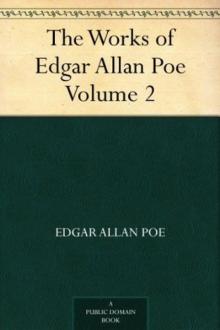 The Works of Edgar Allan Poe — Volume 2
The Works of Edgar Allan Poe — Volume 2 The Works of Edgar Allan Poe — Volume 1
The Works of Edgar Allan Poe — Volume 1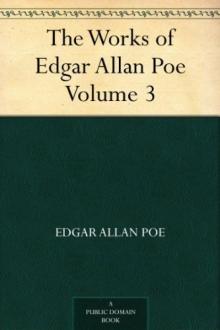 The Works of Edgar Allan Poe — Volume 3
The Works of Edgar Allan Poe — Volume 3 The Works of Edgar Allan Poe — Volume 5
The Works of Edgar Allan Poe — Volume 5 The Works of Edgar Allan Poe — Volume 4
The Works of Edgar Allan Poe — Volume 4 The Tell-Tale Heart
The Tell-Tale Heart The Raven (Penguin)
The Raven (Penguin)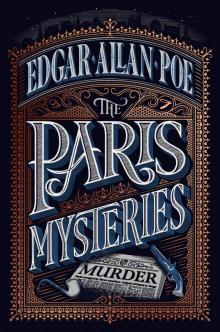 The Paris Mysteries
The Paris Mysteries Tales of Terror from Edgar Allan Poe
Tales of Terror from Edgar Allan Poe The Fall of the House of Usher
The Fall of the House of Usher The Golden Book of World's Greatest Mysteries
The Golden Book of World's Greatest Mysteries The Narrative of Arthur Gordon Pym of Nantucket
The Narrative of Arthur Gordon Pym of Nantucket Ligeia
Ligeia The Landscape Garden
The Landscape Garden Complete Tales & Poems
Complete Tales & Poems Great Tales and Poems of Edgar Allan Poe
Great Tales and Poems of Edgar Allan Poe The Colloquy of Monos and Una
The Colloquy of Monos and Una The Oblong Box
The Oblong Box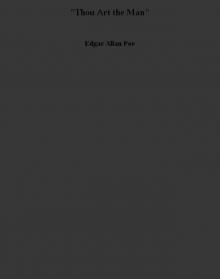 Thou Art the Man
Thou Art the Man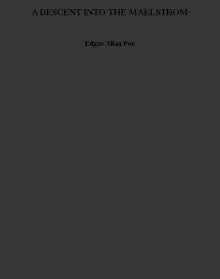 A DESCENT INTO THE MAELSTROM
A DESCENT INTO THE MAELSTROM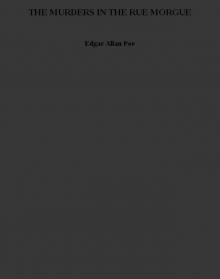 THE MURDERS IN THE RUE MORGUE
THE MURDERS IN THE RUE MORGUE The Business Man
The Business Man The Mystery of Marie Rogêt
The Mystery of Marie Rogêt Metzengerstein
Metzengerstein The Man That Was Used Up
The Man That Was Used Up William Wilson
William Wilson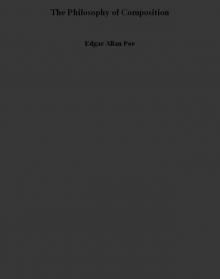 The Philosophy of Composition
The Philosophy of Composition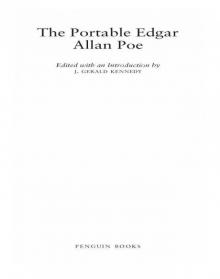 The Portable Edgar Allan Poe
The Portable Edgar Allan Poe Bon-Bon
Bon-Bon A Predicament
A Predicament The Premature Burial
The Premature Burial The Angel of the Odd
The Angel of the Odd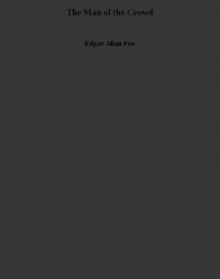 The Man of the Crowd
The Man of the Crowd Never Bet the Devil Your Head
Never Bet the Devil Your Head The Tell-Tale Heart and Other Writings
The Tell-Tale Heart and Other Writings The System of Doctor Tarr and Professor Fether
The System of Doctor Tarr and Professor Fether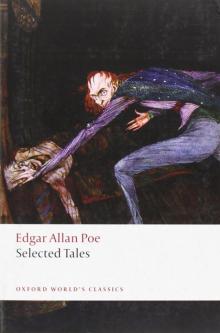 Selected Tales (Oxford World's Classics)
Selected Tales (Oxford World's Classics)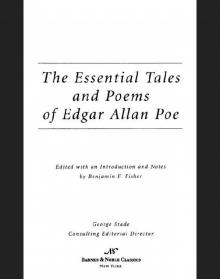 Essential Tales and Poems of Edgar Allan Poe (Barnes & Noble Classics Series)
Essential Tales and Poems of Edgar Allan Poe (Barnes & Noble Classics Series) MS. Found in a Bottle
MS. Found in a Bottle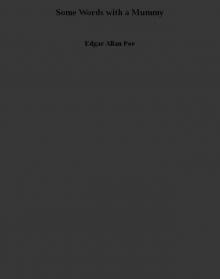 Some Words with a Mummy
Some Words with a Mummy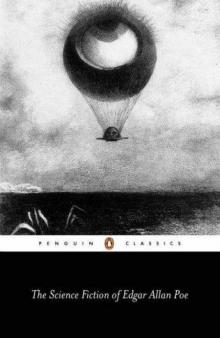 The Science Fiction of Edgar Allan Poe (Penguin Classics)
The Science Fiction of Edgar Allan Poe (Penguin Classics) King Pest
King Pest CRITICISM
CRITICISM How to Write a Blackwood Article
How to Write a Blackwood Article Mystification
Mystification Diddling Considered as One of the Exact Sciences
Diddling Considered as One of the Exact Sciences Steampunk Poe
Steampunk Poe The Literary Life of Thingum Bob, Esq.
The Literary Life of Thingum Bob, Esq. Classic Crime Collection
Classic Crime Collection Complete Stories and Poems of Edgar Allen Poe
Complete Stories and Poems of Edgar Allen Poe Berenice
Berenice The Black Cat
The Black Cat The Slender Poe Anthology
The Slender Poe Anthology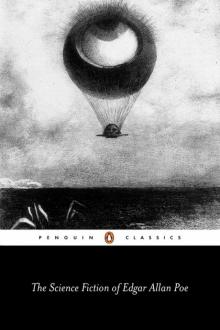 The Science Fiction of Edgar Allan Poe
The Science Fiction of Edgar Allan Poe The Assignation
The Assignation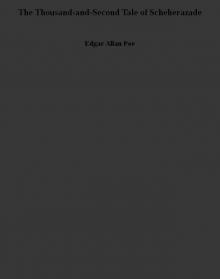 The Thousand-and-Second Tale of Scheherazade
The Thousand-and-Second Tale of Scheherazade The Raven and Other Short Stories
The Raven and Other Short Stories The Spectacles
The Spectacles Hop-Frog
Hop-Frog The Purloined Letter
The Purloined Letter Mellonta Tauta
Mellonta Tauta The Balloon-Hoax
The Balloon-Hoax Landor's Cottage
Landor's Cottage Mesmeric Revelation
Mesmeric Revelation The Pit and the Pendulum
The Pit and the Pendulum